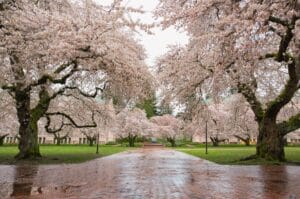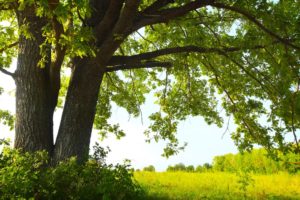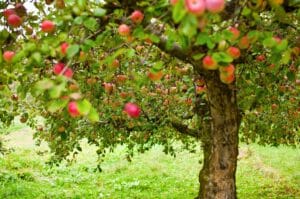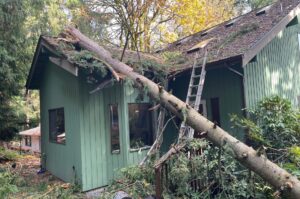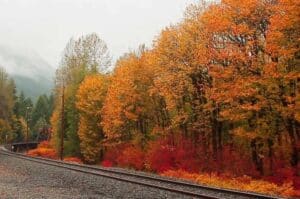Seattle Tree Care Arborists are here to help with Seattle’s changing tree protection code
See our article on the updated Seattle Tree Protection Ordinance Your trusted local tree experts are determined to speak tree code in a way homeowners can understand. Seattle Tree Care owner Kelsey Gruenwoldt holds a stack of wrinkled project bid sheets she recently found while clearing out a storage closet
See our article on the updated Seattle Tree Protection Ordinance
Your trusted local tree experts are determined to speak tree code in a way homeowners can understand.
Seattle Tree Care owner Kelsey Gruenwoldt holds a stack of wrinkled project bid sheets she recently found while clearing out a storage closet at the company’s home base in Magnolia.
The carbon copies are from 2011, back when Seattle Tree Care was called Treecycle and Gruenwoldt’s business served hundreds of homeowners instead of the 1,000 it served in 2021.
“It was a different era of tree care back then,” Gruenwoldt said. Now, her company is preparing for the November 10 additions to Seattle’s tree protection code, Ordinance 126554. With it, Gruenwoldt is expecting significant changes to Seattle’s current era of private tree management.
Explaining Ordinance 126554
City Council’s new ordinance requires that private property owners hire a company registered with the Seattle Department of Construction and Inspection (SDCI) for something the City calls “commercial tree work.”
“Commercial tree work” includes removal of trees with trunks six inches or greater in diameter— measured four and a half feet from the ground— and, for the first time in Seattle tree code history, pruning of branches with a diameter of two inches or greater.
If a homeowner hires an unregistered company for such work, they could face substantial fines from the City and even jail time for non-compliance.
To be included in the registry, a company must be licensed, insured, and reapply for the qualification each year.
“That registered tree service provider has to have a ISA Certified Arborist on staff or on retainer,” explained Andrea Starbird, an ISA Certified Arborist at Seattle Tree Care with a municipal speciality.
Standards for Tree Care
For those not familiar with the term, ISA Certified means the Arborist has earned and must maintain a certification from the International Society of Arboriculture, a nongovernmental green-industry organization. This certification is the tree industry’s foundation for necessary knowledge and understanding of tree biology, safety, and maintenance practices.
Another requirement for companies on the SDCI registry is to conduct all tree work according to ANSI A300 standards, a term that means very little to the average homeowner.
“ANSI stands for the American National Standards Institute,” explained Gruenwoldt. “It’s a collective effort of green industry organizations, the government, and arborists to unify and regulate the tree care industry.”
The ANSI-A300 standards are used to build training materials and care specifications covering everything from tree pruning to soil, pest, and root management. In the case of pruning, these standards require a systematic approach that starts with defining pruning objectives and a consideration of tree species, age, and placement.
The Code’s Impact
While none of the SDCI registry qualifications will be an obstacle for Seattle Tree Care, which already follows ANSI A300 standards and employs 12 ISA Certified Arborists, Gruenwoldt expects homeowners will feel the weight of added responsibility the most.
“One of the reasons these code changes are such a big deal is that they apply to most of the tree work Seattle residents consider routine,” Gruenwoldt said. Of the 2,572 pruning projects Gruenwoldt’s Arborist team completed last year, 72% would fall under the new ordinance’s restrictions.
“I think people are going to be a lot more knowledgeable about trees and the codes that they’re subject to,” Starbird said.
A Home for Trees and People
Gruenwoldt, who grew up in Capitol Hill, sees proper arboricultural care as a way for people and trees to live harmoniously in a tight urban environment. The pruning Seattle Tree Care does can be purely aesthetic, she said, but it’s always done with the health and longevity of the tree at top of mind.
“We want to help people love their trees even more by helping them fit into a client’s vision for their property, and through teaching them how to care for them in the best possible way,” she said.
What’s more, Gruenwoldt added, pruning dead and potentially hazardous branches out of aging trees is important. Her company offers 24/7 emergency tree work and rescues at least 5 houses each year from fallen trees.
“Especially with storm season coming,” Gruenwoldt said, “our minds are on keeping our clients and their families safe.”
Recent Articles
Looking for More?
We've got you covered with tips, resources, updates, how-to's, and other helpful information about trees and landscapes in Seattle, Puget Sound, and King County, WA. Join the thousands of smart local residents who get the monthly newsletter from Seattle Tree Care for helpful information you won't want to miss!
There's no spam - we promise! We are committed to keeping your e-mail address confidential. We do not sell, rent, or lease our contact data or lists to third parties.


